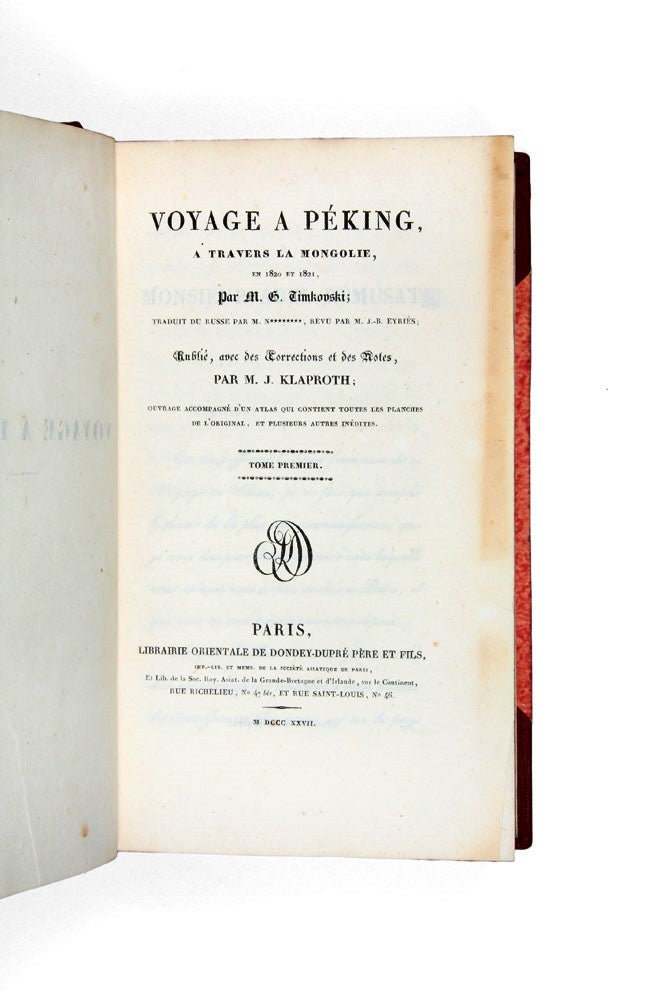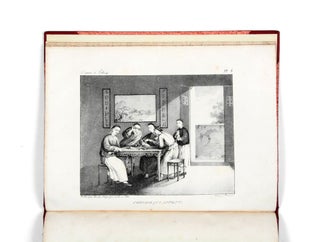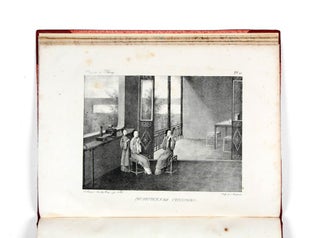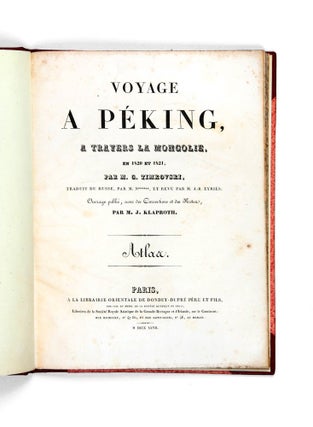Voyage à Peking, à travers la Mongolie en 1820 et 1821…
Voyage à Peking, à travers la Mongolie en 1820 et 1821. Traduit du russe par M. N., revu par M. J.-B. Eyriès
Paris: Dondey-Dupré père et fils, 1826-1827.
Two octavo volumes bound in one, and a quarto atlas with lithographic title page, large folding map, two folding plans and eight lithographic plates; matching later quarter crimson morocco.
A Russian envoy to China
First French edition, recounting the experiences of a Russian envoy to China in the years 1820-1821. Significantly, the atlas volume includes a large plan of the Forbidden City, the first to be published in a Western book. The author, Russian diplomat Egor Fedorovich Timkovski, accompanied the Russian Orthodox mission to Beijing departing Kyakhta in August 1820. Russia had maintained a presence in Beijing since 1728. As the embassy contained a church and school, it formed a centre of cultural exchange, language instruction and diplomatic activity between two great empires. The staff of the embassy were refreshed each decade, providing the need for ongoing missions from Russia to the Imperial Court.
First French edition, recounting the experiences of a Russian envoy to China in the years 1820-1821. Significantly, the atlas volume includes a large plan of the Forbidden City, the first to be published in a Western book. The author, Russian diplomat Egor Fedorovich Timkovski, accompanied the Russian Orthodox mission to Beijing departing Kyakhta in August 1820. Russia had maintained a presence in Beijing since 1728. As the embassy contained a church and school, it formed a centre of cultural exchange, language instruction and diplomatic activity between two great empires. The staff of the embassy were refreshed each decade, providing the need for ongoing missions from Russia to the Imperial Court.
Timkovski's account was considered one of the most important China books of its era, on account of the information he obtained from the long serving Orthodox priests at the Peking embassy. With years of cultural exposure and formidable linguistic competence, the priests provided Timkovski with rich descriptions of Mongol customs and religious life, and enough additional information to expand the scope of his book to Eastern Turkestan, Tibet and Korea. Immediately popular, it was translated and published in German, Dutch, French, English and Polish editions by 1828.
Eight lithographic plates of customs and costumes provide an unusually serene and intimate insight into everyday life, depicting a mounted nomad, musicians, gamblers, a Manchu couple in formal dress and a remarkable grouping of four hunters dressed in furs. The large folding map accurately charts the route of the embassy to Beijing through Mongolia, providing a novel and accurate geographical record of the vast Gobi desert.
Timkovski's narrative was edited for publication by accomplished orientalist and explorer Heinrich Klaproth, who had previously travelled through Mongolia in 1805-1807 as part of an unsuccessful Russian embassy to the Imperial Court. Klaproth contributes a statistical overview to the atlas, detailing the wealth, agricultural output, and population of each of the Chinese provinces. Interestingly, he totals some 142,326,734 souls for the entire nation.
Cordier, 2473-74; Lowendahl, 'China Illustrata Nova', 101; Lust, 551.
Condition Report: Occasional scattered foxing, a very good set.
Price (AUD): $2,850.00
US$1,837.09 Other currencies





